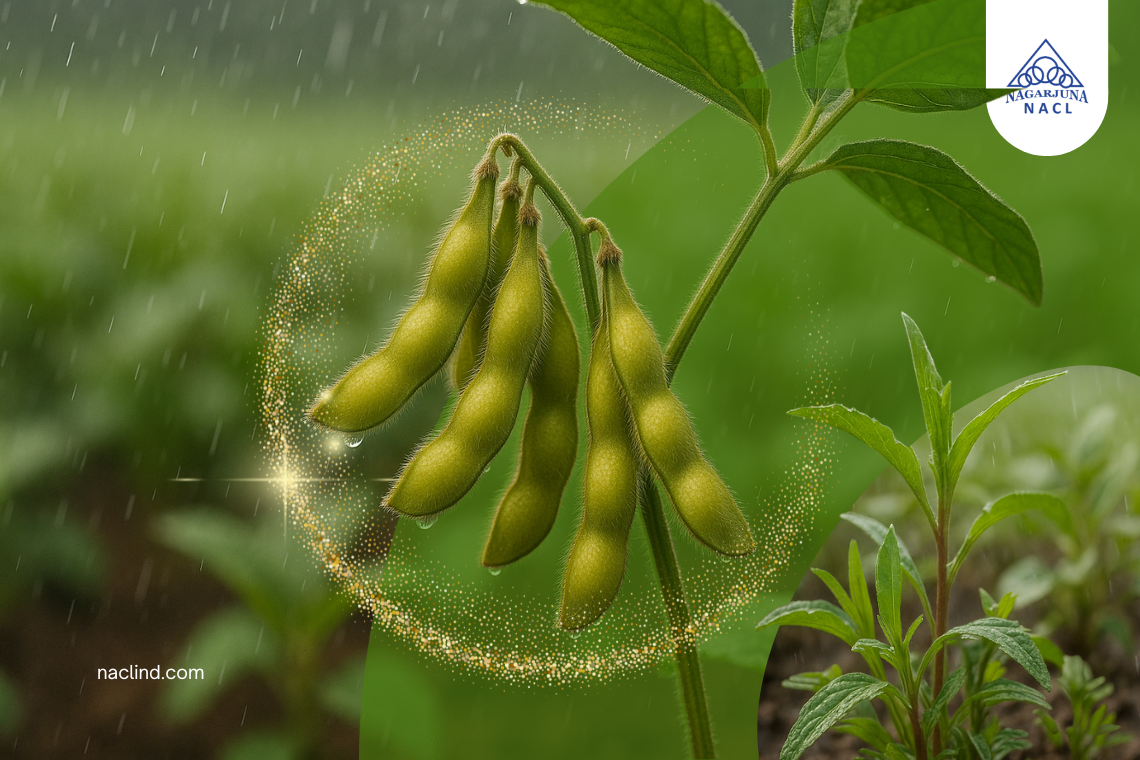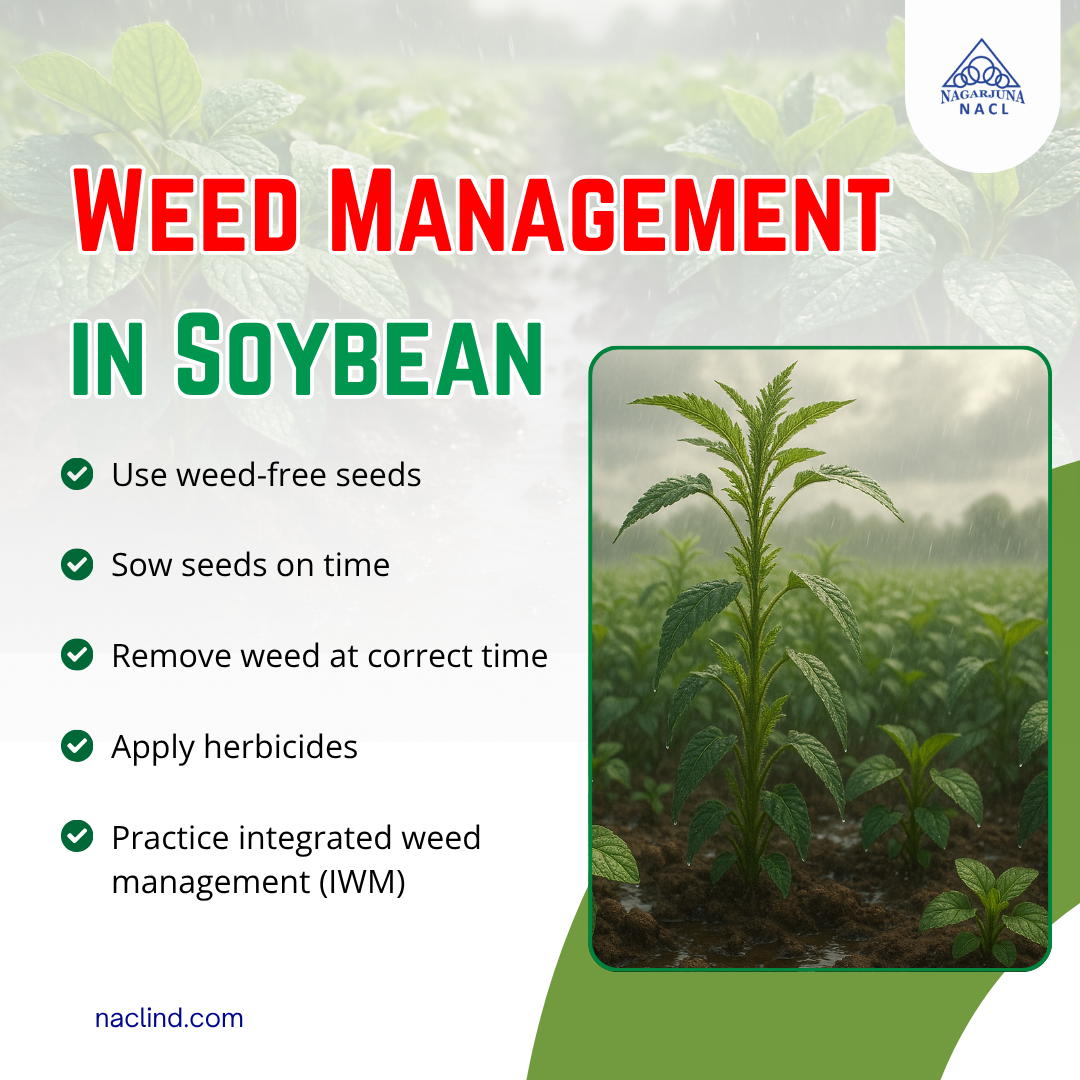
Monsoon Weed Challenges in Soyabean—Solutions You Can Trust
Soyabean farming is one of the fastest-growing agricultural practices in India and worldwide. Known as the “golden bean,” the soyabean crop has become a key cash crop for farmers. However, the success of soyabean cultivation largely depends on how effectively farmers manage weeds, especially during the monsoon season.
Monsoons bring life to crops, but it also encourages rapid weed growth. The warm, humid climate and heavy rainfall create the perfect environment for weeds to thrive.
If left unchecked, weeds can compete aggressively with soyabeans for nutrients, sunlight, and water. This not only reduces yield but also increases production costs. Let’s explore the challenges that weeds pose during the monsoon and the solutions that farmers can rely on.
Why Weeds Are a Big Problem in Soyabean
Soyabeans is a relatively slow-growing crop in their early stages. Within the first 40–50 days, soyabean plants struggle to compete effectively with fast-growing weeds. This “critical weed-free period” is when farmers must pay special attention.
Here’s why weeds cause such damage:
- Competition for nutrients & soil moisture: Weeds consume Nitrogen (N), Phosphorus (P), Potassium (K) and soil moisture at a faster rate due to their deep and extensive root systems, thus creating a deficit for the soyabean crop.
- Shade Effect: Tall weeds block sunlight, leading to weak soyabean growth, slowing down photosynthesis & ultimately reducing crop yield.
- Disease Spread: Certain weeds harbor pests and diseases that can easily transfer to soybean crops.
- Yield Loss: Studies have shown that uncontrolled weeds can reduce soyabean yields by 30–70%.
Common Weeds in Soyabean Fields During Monsoon
Several weed species flourish in soyabean fields during the rainy season. Farmers often struggle with both broadleaf, sedges and narrow leaf weeds.
Some of the most common ones are:
- Echinochloa colona (Jungle rice) – A grassy weed that grows fast in moist fields.
- Cyperus rotundus (Nutgrass) – Spreads aggressively through underground tubers.
- Amaranthus species (Pigweed) – Tall, broadleaf weeds that shade soyabean plants.
- Parthenium hysterophorus (Congress grass) – Highly competitive and harmful to human health.
- Digitaria sanguinalis (Crabgrass) – A problematic weed that quickly multiplies in wet soils.
Identifying these weeds early is the first step toward managing them effectively.
Enhance your yield with advanced crop protection solutions that safeguard crops from weeds and diseases, ensuring a healthier and more profitable harvest.
Challenges Farmers Face in Weed Control
While weed management sounds simple, the monsoon season brings unique hurdles:
- Continuous Weed Germination: Rain encourages multiple flushes of weeds throughout the season.
- Labor Shortages: Manual weeding becomes difficult due to labor scarcity and muddy fields.
- Chemical Misuse: The overuse or improper timing of herbicides can harm soyabean crops.
- Cost Factor: Repeated weeding increase expenses, reducing profit margins.
- Environmental Impact: Excessive herbicide use can harm soil health and contaminate nearby water sources.

Trusted Solutions for Weed Management in Soyabean
1. Pre-Planting Practices
Good weed management starts before sowing. Farmers should:
- Use clean seeds free of weed seeds.
- Practice field preparation with deep ploughing and incorporation to bury weed seeds.
- Consider crop rotation with cereals like maize or wheat to break the weed cycle.
2. Timely Sowing
Sowing soyabeans on time gives plants a competitive edge. Delayed sowing often leads to more weed pressure because weeds germinate earlier and grow stronger than the crop.
3. Mechanical and Manual Weeding
Hand weeding and mechanical weeders are traditional yet effective methods. The first weeding is usually needed 20–25 days after sowing, followed by another at 40–45 days. While labor costs are high, this method ensures precise removal of weeds.
4. Mulching
Applying organic mulch (like straw or crop residue) helps suppress weed germination. Mulch also conserves soil moisture, which is valuable during dry spells between rains.
5. Herbicide Use—Smart and Safe
Herbicides are an integral part of modern soyabean farming, but they must be used wisely. Farmers can adopt a two-step herbicide program:
- Pre-emergence Herbicides: Applied within 2–3 days after sowing, before weeds emerge. Products with active ingredients like Pendimethalin provide early weed control.
- Post-emergence Herbicides: Applied when weeds are visible, usually 20–25 days after sowing. Selective herbicides, such as Imazethapyr, target broadleaf weeds without harming soyabeans.
Tips for safe herbicide use:
- Always read the label instructions.
- Apply at the right growth stage of both weeds and crops.
- Avoid spraying during heavy rains or windy conditions.
- Rotate herbicides to prevent resistance.
6. Integrated Weed Management (IWM)
No single method works best in isolation. Farmers should combine cultural, mechanical, and chemical practices for long-term success. IWM ensures effective control while protecting soil health and biodiversity.
Benefits of Effective Weed Control
When weeds are managed properly, farmers can enjoy:
- Higher Yields: Soyabean plants grow healthier and more productive.
- Reduced Costs: Less competition means fewer fertilizer and water needs.
- Improved Crop Quality: Beans are uniform and free from contamination.
- Sustainable Farming: Balanced weed management protects soil and the environment.
The Top Agrochemical Companies in India manufacture a diverse range of premium products including insecticides, herbicides, and Plant Growth Regulators, designed to suit various crop types and better weed control.
Practical Tips for Farmers During Monsoon
- Inspect fields regularly after rain for new weed flushes.
- Do not delay the first round of weeding. Early action saves time and money.
- Mix herbicide use with manual weeding for better results.
- Keep records of herbicide types and application timings to track the effectiveness of the treatments.
- Train laborers on the correct techniques for weeding and spraying.
Explore the best herbicide for farming that is formulated to deliver powerful, lasting weed control, ensuring healthier plants and significantly higher yields.
Conclusion
Soyabean farming during the monsoon season presents its own share of weed-related challenges. However, with timely action, integrated weed management, and smart use of herbicides, farmers can protect their crops and secure higher yields.
The key is to act early, stay consistent, and rely on trusted solutions that strike a balance between productivity and sustainability. Monsoon weeds will always be a challenge, but with the right approach, farmers can turn the season into an opportunity for growth and success.
Partner with the trusted agrochemical suppliers offering high-quality crop protection products to boost plant health, to protect yields, and to support sustainable farming practices.

